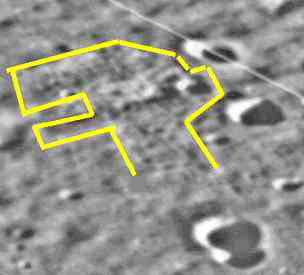|
by Michael Bara 1998 from LunarAnomalies Website
LO-III-123M sent to me by Steve Troy showing his original markups and recommended sectionals. I have added scale markers and references.
Hortensius is an equatorial [6 degrees N, 28 degrees W] near-side 14
km crater just southwest of Copernicus. The region is dominated by a
series of volcanic domes stretching several hundred miles north of
the crater itself.
Note rectilinear pattern all across the sectional image and
especially the very odd looking "dunes" in the area of the arrow. I
also thought that the underside of the crater just above the right
corner of the arrowhead looked quite strange, and Steve had noticed
the bright triangular region just to the left of this crater (above
the framelet line) and dubbed it the "Fan". I proceeded to scan
these two areas at high resolutions.
Wide perspective This stunning region is about 4 x 3 kilometers, judging by the size of Hortensius C. It is dominated by triangular "hanger doors" leading to semi-recessed bunker like structures, and a stunning black box shaped object the size of a 10 story building. In addition, the pronounced right angle pattern in the foreground is reminiscent of barely covered tunnel network. There is also a striking symmetry in the exposed areas (the T-shaped feature behind the "building" for instance).
There are parallel terraces all along
the right side of this "Factory", and perpendicular striations
(access roads?) around the "bunkers". Conceivably, the "Tunnel
Network" could be lava tubes formed in the ancient past similar to
riles and ridges seen in other regions of the moon. However, it
should also be observed that such tubes have been proposed as ideal
locations for eventual human bases on the Lunar surface because they
provide easily sealed off cavities with natural protection from the
harsh radiation and temperature variations that would be
encountered.[1]
This series of raised, parallel triangular openings are recessed
into the surrounding terrain, and compare favorably to the Iraqi
Hardened Aircraft Bunkers shown at right. Notice the similarity of
structure and scale between the features in each photo. The major
difference is that the Iraqi bunkers are exposed in the flat Persian
Gulf desert, while the Hortensius openings are dug in to terraced
Lunar topography. This reinforces the impression of a factory or
storage complex. Note also the straight line behind the first set of
"bunkers" and compare it with the access roads behind the Iraqi
site. Organized facilities display regular, repeating patterns and
identical features over wide distances. Natural formations are far
more random.
Notice that there is no discernable rim, and compare it with
countless other examples of sharp edged impact regions across the
Lunar landscape. The "Lincoln Memorial" itself is a
roughly cubic
shape, with spherical nodes or buttresses at the base along the
"plank". There is a strange webbing behind the "Memorial", faintly
visible in the darkness of the recessed area. Lincoln also seems to
have a "head", approximately spherical and casting a vast shadow
over his "chest". To the right, a canister like object seems to be
linking the "plank" to the main body of the facility.
This ultra-high resolution scan of the top of the "Lincoln Memorial"
displays many exotic aspects of this unique structure. Note the
overall symmetry, the flat platform underneath the shadow and the
spherical nodes at either end. The "Head" itself is revealed as a
rounded shape, and it is clearly in front of the odd "webbing" in
the background. The flat projection at the base of the shadow
appears to be an opening or landing platform. This "platform" has a
wall like enclosure which seems to have a partially closed door
mechanism.
Many characteristics of the "Factory", and indeed the entire Hortensius region are evocative of the "Arcology" concept first described by Paolo Solari. Note the tiered, protected portions backed by raised structures, enclosed by yet larger structures. The "Factory" represents one of the best illustrations of the use of this concept. This resemblance alone is a significant pillar of the artificiality argument.
Enlargement of "Dish" and "Fan" and exposed structural girders. Just above and to the right of the "Factory" region is another set of anomalous features. Beyond the familiar pitted terrain, there are a number of features that are difficult to explain as natural. The crater itself is approximately 2 KM across and seems to be of the collapse variety. The bright triangular area just above the framelet line was what Steve Troy originally noted and dubbed the "Fan".
On closer inspection the fan seems to consist of two intersecting structural members barely poking through the regolith. They are very linear and have regularly spaced "Lightening holes", or dark areas, in them. There is also a dark rectangular depression just above the "Fan" that has sides perpendicular to the proposed structural girders.
The "Fan" with the
dark box marked up
The "Fan" showing proposed girders and lightening holes
As I studied the image I was struck by what appeared to be an edge to the crater on lower left side just below the framelet line. Note that there is a distinct rim in this portion of the image.
Given the shadow length, I was also a bit disturbed by the dark zone just below and to the right of the crater rim. If this were a normal crater, the area should be illuminated rather than pit black. It occurred to me that there must have been a collapse of the surface skin in this dark zone.
By all rights, this should be a lopsided
partial crater with a significant build up of collapse material in
the dark zone. The problem then becomes; "What is providing the
structural stiffness of the crater itself?"
Note also the parallel lines making up segments of the "Strut" are aligned at this same angle, rather than running along the direction of the surrounding terrain. It has all the earmarks of an spring loaded strut, similar to the earthquake absorption systems in modern office buildings. There is also an odd jagged edge on the right portion of the deeply shadowed area, as if a plate or board was broken by an impact.
The shadowed area, support "Strut" and "Girder", and marked up
version, right. Underneath the "Strut" is an object easily recognizable as "I-Beam" or girder with lightening holes. This is similar to other such girders just North of the "Dish" in the "Fan" area. It seems to be slightly stressed and bent under the "Strut". It has a central web, raised sides (or flanges) and equally spaced "Lightening Holes". I believe that the middle Lightening Hole is slightly distorted by the vertical line (which may be a defect) passing just through the middle of it. Compare it with the crude sketch below.
Top and side views of a typical structural girder.
This area, approximately 4 X 4 km, is an astonishingly structured complex series of rectilinear patterns southeast of the "Factory". It is seated in a much broader pattern of rectilinear features in the adjacent territory which are parallel to each other along a vast network.
(This
view has not been orthographically corrected, excluding that as a
possible explanation of the "Square" crater.)
When the mark-up version is compared to the larger enhancement
above, the outlines of this foundation become clear. This organized
internal structure separates it from the more random "D" shaped
caldera and are suggestive of a city or town viewed from the air.
The presence of volcanic domes and
possible lava tubes in the immediate vicinity encourage the adoption
of this model as the alternative to the artificiality hypothesis.
Unfortunately, the volcanism explanation fails miserably when faced
with the indisputable fact that it bears no resemblance to any
volcanic region either on the Moon or elsewhere in the Solar system.
The terraced multi-level topography and recessed bunker formations
are indicative of military installations in remote areas of Earth,
and the "Lincoln Memorial" evokes comparisons with power plants
other large-scale facilities.
|

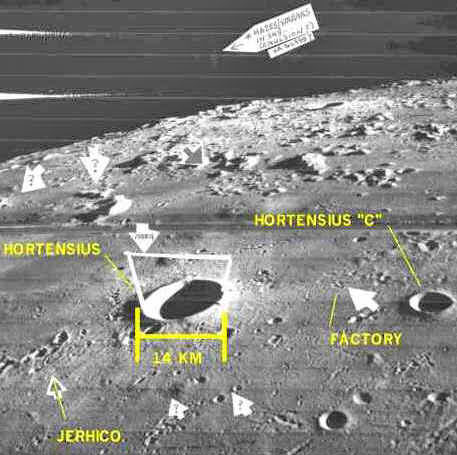
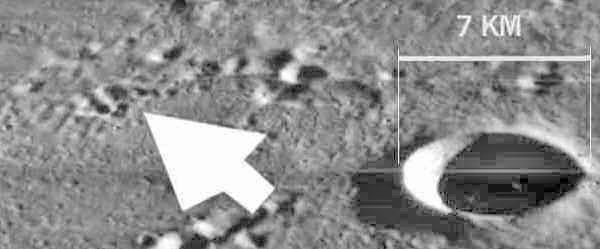
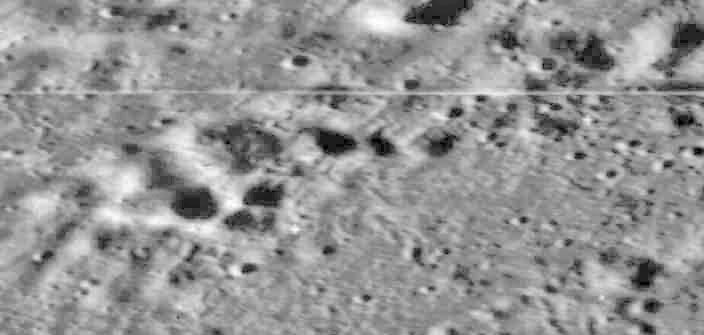
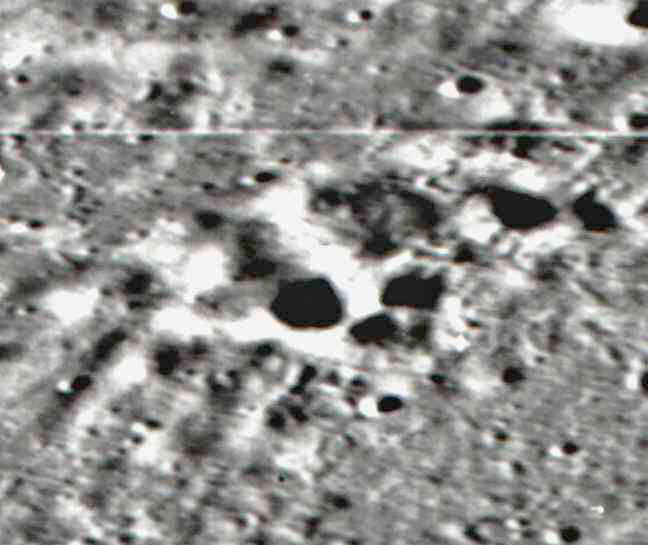
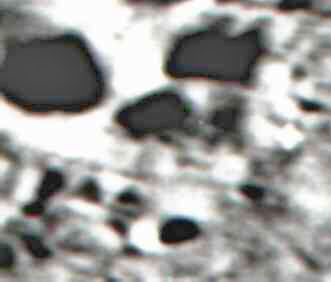
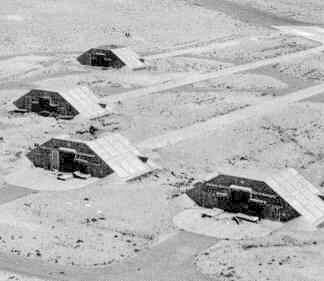
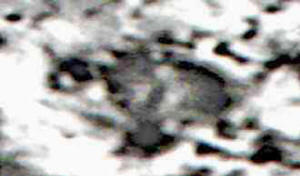 Quite simply, there is no conventional natural explanation for this
set of objects. Indeed, there is no conceivable geologic process or
set of processes which can account for these structures. The large
black "monolith" in the center of the image is resting on a
rectangular "plank" stretching across a gaping chasm ( I hesitate to
refer to it as a crater, since it has virtually no crater-like
characteristics). If there is a crater there, it is decidedly
rectangular, and has some very strange aspects to itís appearance.
Quite simply, there is no conventional natural explanation for this
set of objects. Indeed, there is no conceivable geologic process or
set of processes which can account for these structures. The large
black "monolith" in the center of the image is resting on a
rectangular "plank" stretching across a gaping chasm ( I hesitate to
refer to it as a crater, since it has virtually no crater-like
characteristics). If there is a crater there, it is decidedly
rectangular, and has some very strange aspects to itís appearance. 
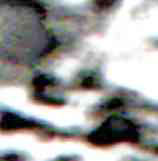 The "Truss" has cylindrical central body spanning the "plank" and
the edge of the "terraces". It is anchored at both ends by a
half-slot shaped end cap which extends to the ground on each side.
The archway underneath the cylindrical shape is plainly visible.
This object would appear to be a support or reinforcing member
holding the "plank" up.
The "Truss" has cylindrical central body spanning the "plank" and
the edge of the "terraces". It is anchored at both ends by a
half-slot shaped end cap which extends to the ground on each side.
The archway underneath the cylindrical shape is plainly visible.
This object would appear to be a support or reinforcing member
holding the "plank" up.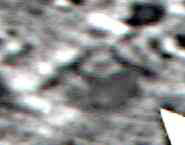 Just to the upper right of the "Factory" area is another anomalous
feature. Jutting from the top of a darkened recess is this
symmetrical disk shaped object. Notice it is supported from the
upper rear by a strut, and that the surrounding terrain seems to
flow into the darkness below it, as if this were the entrance to an
underground bunker or complex. Given itís location adjacent to the
"Factory", this may indeed be precisely that. Note the generally
square shape of the opening, and again the even symmetry of the both
the "Overhang" itself and chasm it seems to guard. There is also a
light, dome shaped node just beneath the "Overhang" in the darkened
area which may be indicative of light (from the nearly directly
overhead sun) creeping through thinned areas of the "Overhang"
itself, or possibly of some form of self luminescence. A final
possibility is that the "Overhang" itself has a light source in its
central disk and this is projecting downward.
Just to the upper right of the "Factory" area is another anomalous
feature. Jutting from the top of a darkened recess is this
symmetrical disk shaped object. Notice it is supported from the
upper rear by a strut, and that the surrounding terrain seems to
flow into the darkness below it, as if this were the entrance to an
underground bunker or complex. Given itís location adjacent to the
"Factory", this may indeed be precisely that. Note the generally
square shape of the opening, and again the even symmetry of the both
the "Overhang" itself and chasm it seems to guard. There is also a
light, dome shaped node just beneath the "Overhang" in the darkened
area which may be indicative of light (from the nearly directly
overhead sun) creeping through thinned areas of the "Overhang"
itself, or possibly of some form of self luminescence. A final
possibility is that the "Overhang" itself has a light source in its
central disk and this is projecting downward.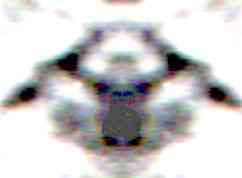
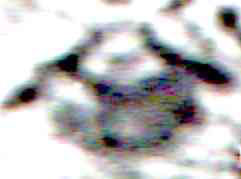 This highly overexposed and enlarged view of the area
(image left) shows that the
light source may be a dome shaped object, or perhaps a feature
similar to the wedge shaped object to the left of the disk which has
broken off from a symmetrical mount on the right hand side. Consider
the image right.
This highly overexposed and enlarged view of the area
(image left) shows that the
light source may be a dome shaped object, or perhaps a feature
similar to the wedge shaped object to the left of the disk which has
broken off from a symmetrical mount on the right hand side. Consider
the image right. 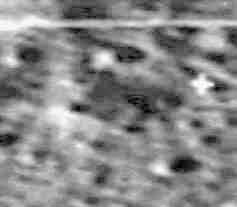
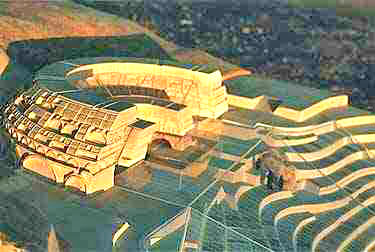
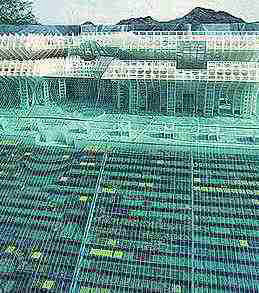
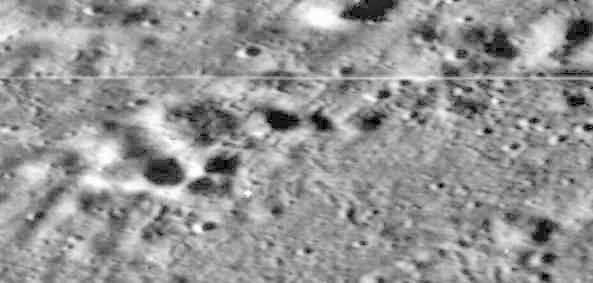
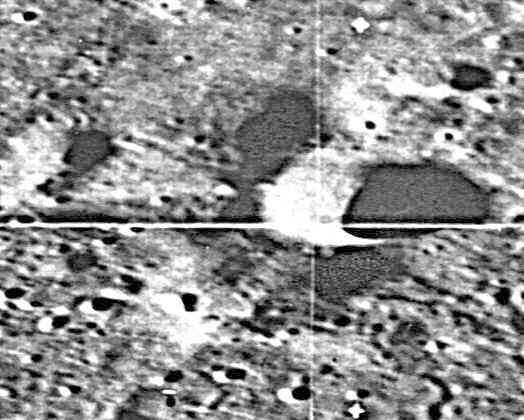
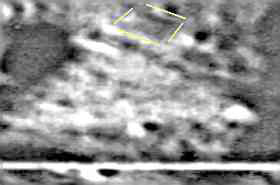
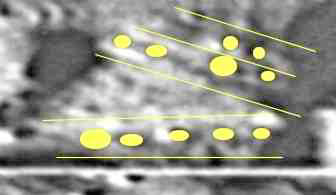
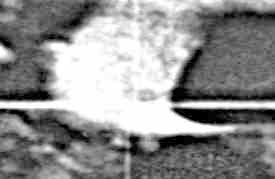
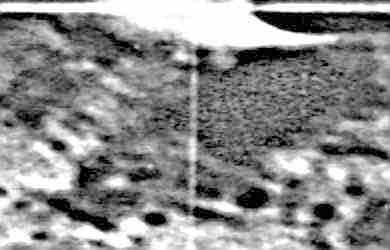
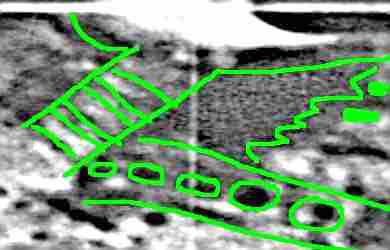
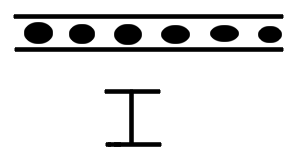
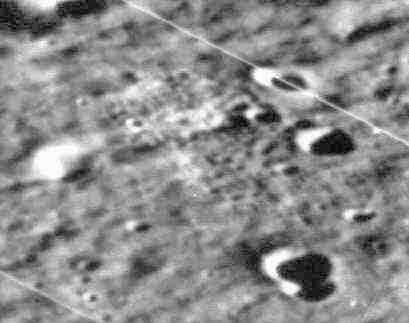
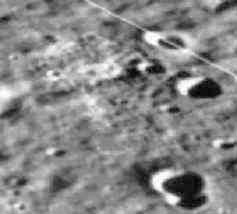
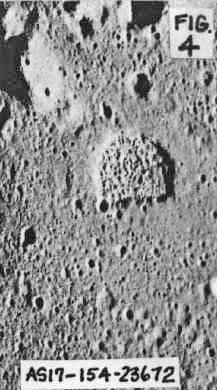 The highly ordered internal geometryís are "walled-in" by a
raised right-angular pattern reminiscent of a building foundation,
but on a much vaster scale. Note also the square crater just below
the framelet line, the twin double or "keyhole" craters, and the
"ramps" descending into the complex from the middle-right.
The highly ordered internal geometryís are "walled-in" by a
raised right-angular pattern reminiscent of a building foundation,
but on a much vaster scale. Note also the square crater just below
the framelet line, the twin double or "keyhole" craters, and the
"ramps" descending into the complex from the middle-right. 